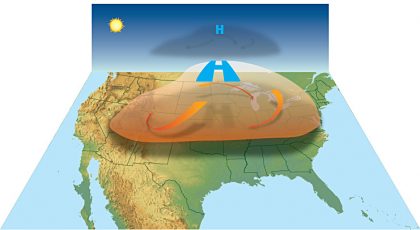As the world is becoming warmer, heatwaves are occurring more frequently. Extreme temperatures have recently hit South America, Australia, and New Zealand where the summers have become not only unbearable for millions of people but deadly too and have also led to droughts and wildfires.
Countries in the Southern Hemisphere are struggling with the scorching heat of the summer months. Some Australian and South American cities have recorded rocketing air temperatures which have never been seen before. Scientists have no doubt that these more frequent and intense heatwaves are a result of climate change and will become the new reality.
See also: South America faces extreme heatwaves, wildfires; agriculture badly impacted
What are heatwaves and what causes them?

Heatwaves are extreme weather events that extend a period of very high temperatures in some areas. They begin with a build-up of high-pressure, also known as anticyclones, in the summer. Atmospheric pressure above the ground then swells creating a sinking column of compressed air which subsequently heats up and often dries out. This sinking air behaves like a heat dome as it traps the heat absorbed by the land. The high pressure then pushes up the cooler air and the hot air stays close to the ground. Soil, sand, concrete, and asphalt quickly capture and accumulate the heat from the sun which leads to a rise in temperature as those surfaces emit the heat. Heatwaves normally last about five days but sometimes this may be longer.
“In some cases, you actually can get these kinds of patterns getting stuck, and that can lead to heatwaves lasting much longer,” explained Karen McKinnon, an Assistant Professor of Environment and Sustainability at the University of California in Los Angeles.
Where do heatwaves occur?
Heatwaves occur mostly in dry areas such as deserts but they can happen in locations where there is a lot of moisture if high-pressure systems are present. Urban areas are especially vulnerable where heatwaves are more extreme compared to green zones or water basins. While buildings, roads, and car parks accumulate heat making the air warmer, natural landscapes absorb it and thus decrease the temperature. This is why we speak of the urban heat island effect when urban areas are very often much warmer than neighboring green zones.
According to research published in Nature in 2018, heatwaves are more frequent in the tropics with tropical zones now experiencing an increase in the number of extremely hot days due to climate change. Large parts of Africa, Central and South America, and South East Asia are seeing 30 more days of heatwave per season while for North America, Europe and Russia there are around 10 to 15 more days. An average of four to eight more days of heatwave are expected for each degree of global warming.
Climate change and heatwaves
Scientists have no doubt that climate change is a key driver of more frequent and potent extreme weather events such as heatwaves.
“Almost any kind of metric related to heatwaves you can imagine is getting worse and is projected to get worse,” said Jane W. Baldwin a postdoctoral fellow at the Lamont-Doherty Earth Observatory at Columbia University.
The explanation for the relationship between extensive heatwaves and climate change is very simple. The more fossil fuels we burn, the more greenhouse gases we emit. Since greenhouse gas trap heat, the more we emit into the atmosphere, the more heat is trapped and thus temperatures rise.
How do heatwaves impact humanity?
The exposure of populations to heatwaves is growing as temperatures continue to increase. According to the World Health Organization (WHO), between 1998 and 2017 heatwaves killed over 166,000 people. Heatwaves may cause dizziness, headaches, and fainting but also more severe conditions such as heat stroke. The most vulnerable groups of people are children, elderly people, and those suffering from chronic conditions.
See also: Heatwaves threaten health and lives of most vulnerable workers worldwide

